The country’s foreign exchange reserves dipped for the second month in a row last May, but remained more than enough to cushion the impact of external shocks, documents from the central bank showed.
The Bangko Sentral ng Pilipinas (BSP) on Friday said its gross international reserves (GIR) settled at $82.9 billion at the end of last month, lower by $300 million from the April level. The country’s GIR reached a record high of $83.95 billion last March.
The international reserves serve as savings that the country can fall back on in case of a sudden halt in inflow of foreign exchange.
The country’s reserves were enough to pay for the country’s imports for 11.7 months. It was also enough to cover 9.8 times the country’s short-term debt payments based on original maturity.
“The slight decline in reserves was due mainly to revaluation adjustments on the BSP’s gold arising from the decrease in the price of [the precious metal] in the international market,” the central bank said in a statement.
The BSP said its reserves were also trimmed down by the payment of maturing dollar loans of the national government and the recent withdrawal of foreign currency deposit by a state-owned firm.
“These outflows were partially offset by inflows from the foreign exchange operations (of the BSP) and income from investments abroad as well as foreign currency deposits by the national government,” the BSP said.
Net international reserves, which refer to the difference between the GIR and the government’s short-term liabilities, de creased by $300 million to $82.9 billion at the end of May, the BSP said.
The BSP’s accumulation of international reserves is largely dependent on the amount of foreign currency that enters the Philippines.
Latest data available from the BSP showed that foreign portfolio investments, commonly referred to as “hot money,” surged to $3.5 billion in April, more than 50 percent higher than the $2.3 billion last March. Portfolio investments are placements in local equities and peso-denominated government securities and other easily tradable instruments.
Meanwhile, foreign direct investments, which are investments by foreign firms in equipment, buildings and other assets for their local operations, rose to $436 million in February 2013 from $192 million in the same month last year.
Data for foreign portfolio and direct investments for the month of May have yet to be released.



